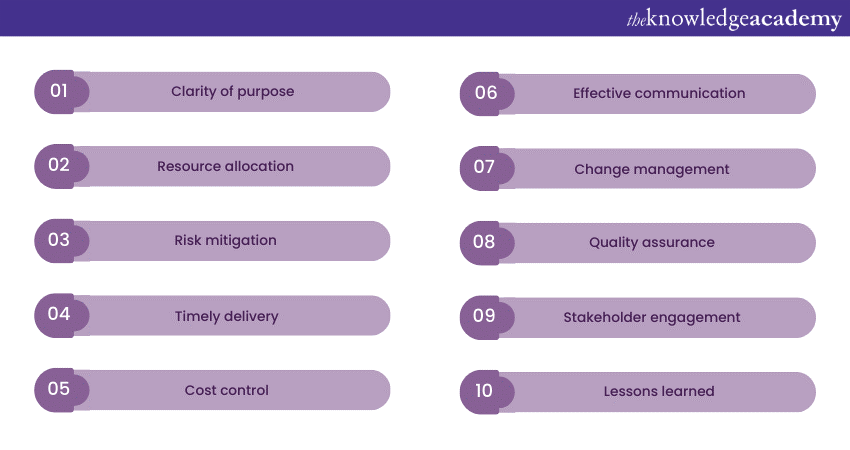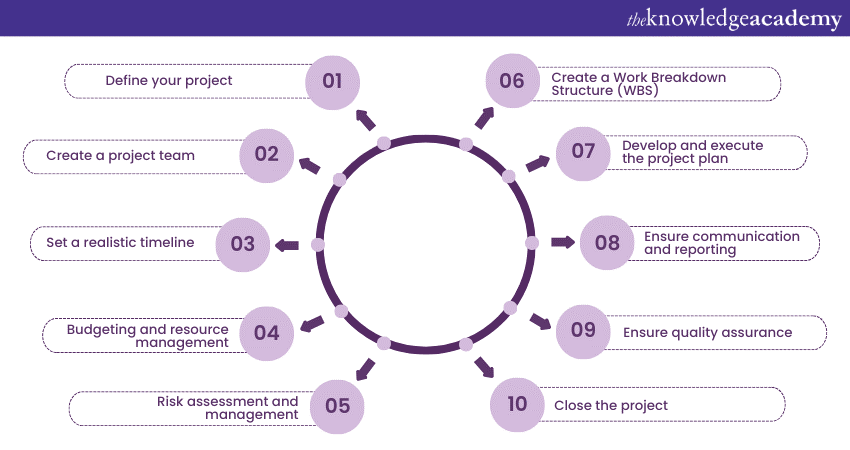We may not have the course you’re looking for. If you enquire or give us a call on +30 2111995372 and speak to our training experts, we may still be able to help with your training requirements.
We ensure quality, budget-alignment, and timely delivery by our expert instructors.

Effective Project Planning is crucial for the successful execution of any project, whether you're a beginner or an experienced Project Manager. It ensures you have a clear roadmap to follow, appropriately allocated resources, and mitigated risks. This blog will look into the essential Project Planning Steps that beginners and experts can use to achieve their project goals.
Table of Contents
1) The importance of Project Planning
2) Project Planning Steps
a) Define your project
b) Create a project team
c) Set a realistic timeline
d) Budgeting and resource management
e) Risk assessment and management
f) Create a Work Breakdown Structure (WBS)
g) Develop and execute the project plan
h) Ensure communication and reporting
i) Ensure quality assurance
j) Close the project
3) Conclusion
The importance of Project Planning
Project Planning is the foundational pillar upon which the success of any project stands. It serves as the compass, guiding every aspect of the project from initiation to completion. Whether you're tackling a small-scale endeavor or a complex, multi-million-pound initiative, Project Planning, as outlined in the Project Planning and Control Guide, is indispensable for several compelling reasons.

Clarity of purpose
At its core, Project Planning forces Stakeholders to define the project's objectives, scope, and goals with precision. This clarity of purpose ensures that everyone involved understands what needs to be achieved and why, reducing the risk of misunderstandings and scope creep.
Resource allocation
Effective Project Planning enables the efficient allocation of resources, including human resources, materials, equipment, and budget. Knowing what resources are needed and when they are required is essential for preventing bottlenecks and ensuring a smooth workflow.
Risk mitigation
Project Planning allows for the identification and assessment of potential risks. By understanding the risks that are associated with a project, stakeholders can develop strategies to mitigate them, reducing the chances of costly setbacks.
Timely delivery
A well-structured project plan includes a realistic timeline with milestones and deadlines. This timeline provides a roadmap for the project team, helping them stay on track and deliver the project within the established timeframe.
Cost control
Through detailed budgeting and cost estimation, Project Planning helps keep project finances in check. It ensures that the project remains within budget, minimising the risk of financial overruns.
Enhance your Project Management skills with our Project Planning and Control Course. Join now and drive project success!
Effective communication
Project Planning involves the creation of a Project Communication Plan, which establishes how information flows within the project team and to external stakeholders. Clear and open communication fosters collaboration, enhances understanding, and builds trust among the team members and stakeholders.
Change management
Even the most meticulously planned projects may encounter changes or unforeseen challenges. Project Planning equips teams with the tools and processes needed to manage change effectively, adapt to new circumstances, and keep the project on course.
Quality assurance
Quality assurance is an integral part of Project Planning, ensuring that deliverables meet defined standards and objectives. It sets a high bar for the quality of work produced throughout the project's lifecycle.
Stakeholder engagement
Engaging stakeholders at the planning stage is critical for aligning their expectations with project objectives. By involving stakeholders early, project planners can secure buy-in and support, which is vital for project success.
Lessons learned
Project Planning isn't merely about the present project; it's also an opportunity to gather insights and learn from past experiences. A well-structured planning process includes a mechanism for capturing lessons learned, which can be invaluable for improving future projects.
Take your first step into Project Management excellence – sign up for our Project Planning And Control Certification today!
Project Planning Steps
This section of the blog will expand on the steps to Successful Project Planning in order.

Define your project
The initial step in Project Planning is to meticulously define your project's objectives, scope, and purpose. This clarity provides a solid foundation for all subsequent decisions and actions. Start by precisely articulating what you aim to accomplish, the desired outcomes, and the constraints or limitations. This definition phase is a critical moment to engage with stakeholders and gather their insights and expectations. A well-defined project ensures that everyone involved is on the same page, reducing the risk of scope creep and misunderstandings down the line.
Create a project team
Building the right project team is akin to assembling a well-coordinated orchestra. It involves selecting individuals with the requisite Project Management Skills and experience to execute project tasks effectively. Assign roles and responsibilities to team members, aligning them with the project's objectives. Communication and collaboration within the team are paramount for project success. Make sure that team members understand their roles and how they contribute to the project's overall goals. A cohesive team can adapt to challenges and changes, fostering a dynamic and responsive project environment.
Set a realistic timeline
Creating a realistic Project Management Timeline is essential to manage expectations and ensure the project stays on track. Begin by estimating the duration of each task, phase, or milestone accurately. Be mindful of dependencies between tasks, as they can impact your schedule. Visual tools like Gantt Charts can help in scheduling and tracking progress. A well-structured timeline provides a sense of direction, allowing you to allocate resources efficiently and manage stakeholder expectations. Striking the perfect balance between ambition and pragmatism in your timeline ensures that your project remains achievable and sustainable.
Budgeting and resource management
Effective budgeting and Project Resource Management are the cornerstones of financial control during a project's lifecycle. Estimate the project's costs meticulously, considering not only direct expenses but also indirect costs. Allocate resources judiciously, ensuring that you have the necessary personnel, materials, and equipment at the right time. It's crucial to maintain a buffer for unforeseen expenses or scope changes. Vigilant resource management prevents wastage and keeps the project financially sound, aligning your expenditure with your objectives.
Risk assessment and management
Identifying and managing risks is central to Project Planning. Begin by identifying potential risks that could disrupt your project's progress. Evaluate the likelihood and impact of every risk, prioritising them based on severity. Develop comprehensive risk response plans that outline actions to mitigate, accept, transfer, or avoid these risks. Review and update your risk management strategy regularly as the project evolves. Proactive risk management minimises surprises and equips your team to respond effectively to unforeseen challenges, safeguarding your project's success.
Create a Work Breakdown Structure (WBS)
The Work Breakdown Structure, or WBS, is defined as a visual tool that dissects your project into manageable components, fostering clarity and organisation. It consists of breaking down the project into smaller, well-defined tasks or subprojects. This decomposition simplifies Project Management by making it easier to assign responsibilities, track progress, and identify dependencies between tasks. A well-structured WBS serves as a roadmap for your project, guiding team members and stakeholders alike. It enhances communication, improves resource allocation, and contributes to smoother Project Execution.
Develop and execute the project plan
The project plan consolidates all planning efforts into a comprehensive document that guides project execution. It outlines objectives, scope, schedule, budget, resources, and risk management strategies. The plan also highlights critical milestones and responsibilities. Once the plan is established, it's time to put it into action. Execute the project plan diligently, monitoring progress and managing changes effectively. Maintain open lines of communication within the team and with stakeholders, ensuring everyone is aware of their responsibilities and any adjustments made along the way.
Ensure communication and reporting
Effective Communication is the lifeblood of any project. Establish a robust communication plan that outlines how information flows within the project team and to stakeholders. Regularly update stakeholders on project progress, milestones achieved, and any challenges encountered. Implement an issue-tracking system to address problems promptly. Effective communication fosters collaboration, keeps stakeholders engaged, and builds trust. Transparent reporting helps stakeholders understand the project's status, reducing uncertainty and the potential for misunderstandings.
Ensure quality assurance
Quality assurance is a continuous process that makes sure that project deliverables meet defined standards and objectives. Establish clear quality standards and criteria for project outputs from the outset. Regularly assess and improve Project Management Processes and deliverables, learning from each project to enhance future performance. Implement quality control measures to review and verify work products, preventing errors and maintaining consistency. Quality assurance isn't an isolated step but should permeate every aspect of your project, ensuring that it consistently delivers on its promises and satisfies stakeholder expectations.
Close the project
Properly closing a project is often overlooked but equally critical as its initiation. Ensure that all project deliverables are completed to the required quality standards. Conduct a “lessons learned” session to gather feedback and insights from the project team. Use this valuable information to improve processes and outcomes for future projects. Evaluate the project's overall success, considering objectives, budget, and schedule. Close out all contracts and financial matters. A well-organised project closure phase leaves a positive impression on stakeholders, sets the stage for future collaborations, and facilitates the transition to ongoing operations or the next project.

Conclusion
To sum it up, the importance of Project Planning Steps cannot be overstated. It is the compass that guides us through the complexities of project execution. Whether you're a newcomer embarking on your first project or an experienced hand seeking to refine your skills, remember this: a well-crafted project plan sets the stage for success, ensuring clarity, resource efficiency, risk mitigation, and the delivery of quality outcomes.
Unlock your full potential in Project Management with our Project Management Masterclass – join today for comprehensive skill enhancement!
Frequently Asked Questions
Upcoming Project Management Resources Batches & Dates
Date
 Project Planning and Control™ (PPC) Foundation
Project Planning and Control™ (PPC) Foundation
Mon 3rd Mar 2025
Tue 6th May 2025
Mon 14th Jul 2025
Mon 8th Sep 2025
Mon 10th Nov 2025






 Top Rated Course
Top Rated Course


 If you wish to make any changes to your course, please
If you wish to make any changes to your course, please


